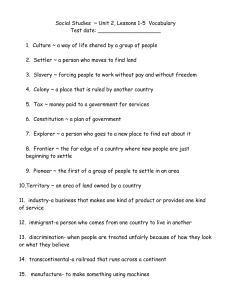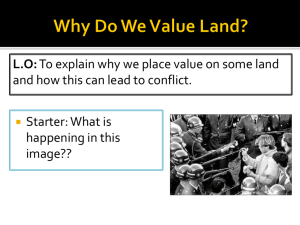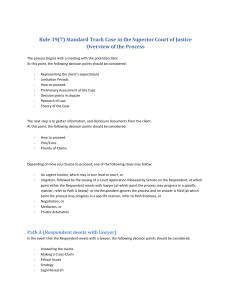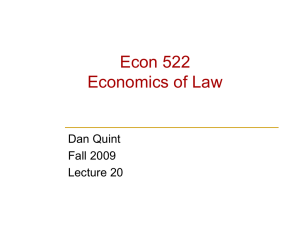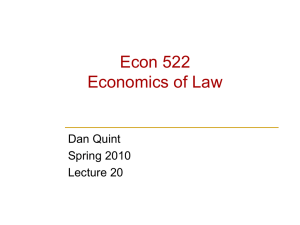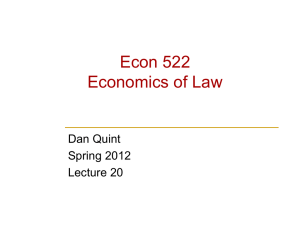Where do people settle and why
advertisement
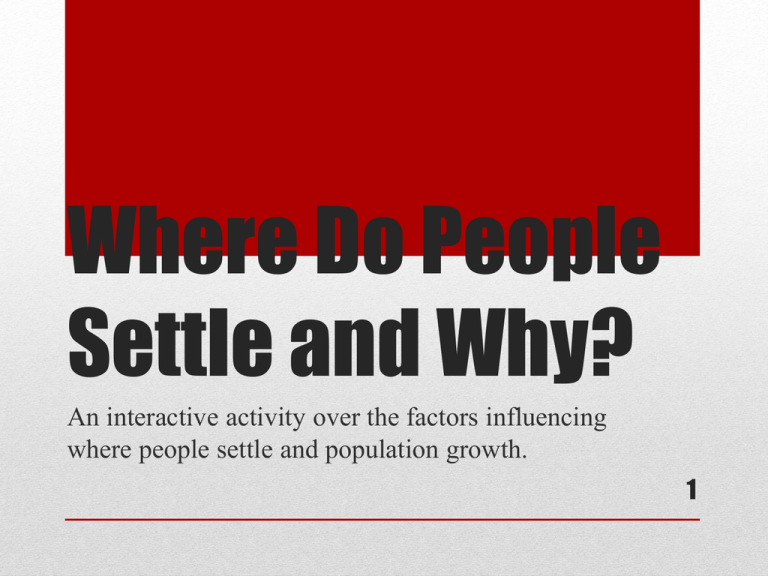
Where Do People Settle and Why? An interactive activity over the factors influencing where people settle and population growth. 1 Where Do People Live? • Human settlement is affected by both physical and human factors. Three- fourths of the world’s population currently live on less than 5% of the earth’s surface. • The majority of the population is concentrated in 5 areas 1. East Asia (China, Korea, Japan and Taiwan) 2. South Asia (India, Pakistan, Bangladesh, and Sri Lanka) 4 3. Southeast Asia 4. Europe 1 5. North America 3 5 2 2 Factors That Affect Where People Settle • There are three main factors that influence settlement patterns of people: 1. Physical Factors 2. Human Factors 3. Changes in Settlement Patterns 3 3 Physical Factors • Physical factors greatly impact where people settle. Population tends to gather around seaports and fresh water sources such as rivers and lakes. Most people live neat the ocean, or near a river with ocean access. Two-thirds of the world’s population live within 500 miles of an ocean. • Much of the Earth’s land surface is unfriendly to human habitation. Eight of the ten most populated cities are on or near earthquake faults. Population is typically sparse in extremely dry, wet, cold or mountainous regions. These areas have a low population density (amount of people living in a specific area). People usually settle in low-lying areas with fertile soil and temperate or mild climates. 4 Click to play video 5 Human Factors • Human factors also impact where people choose to settle. The need to create a capital city at a central location or to build new transportation routes (roads, railroads) may cause people to settle in a particular area. As technology improves, people are able to explore and settle in new areas, even though there are physical barriers such as mountains. Economic activities also bring people to new areas. The discovery of valuable resources, such as gold, diamonds, or oil, may attract people to an area that they normally would not want to live. 6 Click to play video 7 Changes In Settlement Patterns • Settlement patterns sometimes change overtime. As areas urbanize (become cities), surrounding areas become an interest to new settlers. The discovery of new resources or the construction of new transportation routes can also encourage new settlement. The Far West of the United States, for example, was lightly populated until the discovery of gold in California and the creation of the transcontinental railroad. 8 The Set Up of Cities • Throughout history, cities have varied in their size and location. As cities become older they often change. Usually the business district was located in the cities center and surrounded by neighborhoods. As people from the rural areas began to move into the cities, then the wealthier individuals began to move outside of the city. • Recently, suburbs have developed outside of the cities. As these suburban areas grow they create new cities around the older city center. This creates a metropolitan area. • In less developed nations, people from rural areas that move to the cities are often less educated and lack resources. They usually create ‘shanty towns’. The ‘shanty towns’ are poor settlements where poor people live in dwellings made from scrap materials. Suburbs Residential Central Business District Squatter Settlements Squatter Settlements 9 World’s Population 10 Our World’s Population Growth • Settlement patterns and distribution of the world’s population have greatly changed overtime. When agriculture was introduced the world’s population growth began to even out. As agriculture became a way to provide more food for people the population began to gradually increase. • However, famines, plagues, and war kept the world’s population from growing to quickly. • When the Industrial Revolution occurred, Europe and North America were the first two continents to apply the new technology to farming and to use modern science to decrease death rates. • Because of this, population growth accelerated by almost 10 times in Great Britain. However, at this time average birth rates in these regions gradually decreased. This kept the population from growing 11 to quickly. Our World’s Population Growth • Overtime, Europeans began to explore and colonize new areas. As they migrated to these locations they spread their medical technology and their new farming methods. • Both of these technological advancements enabled people to live longer. People where living longer and they often were not decreasing their birth rates with caused the population in areas such as Asia, Africa and Latin America to rapidly increase. • Due to this large increase in population many areas are dealing with the problems of overpopulation and a lack of resources. • Some countries are trying to control their population growth in order to solve this problem. For example, China encourages families within the cities to only have 1 child. 12 Click to play video 13

